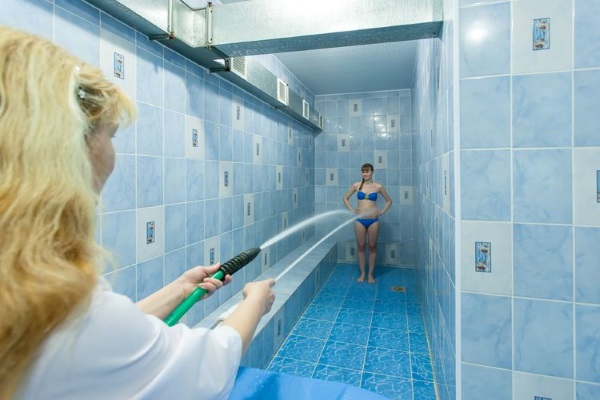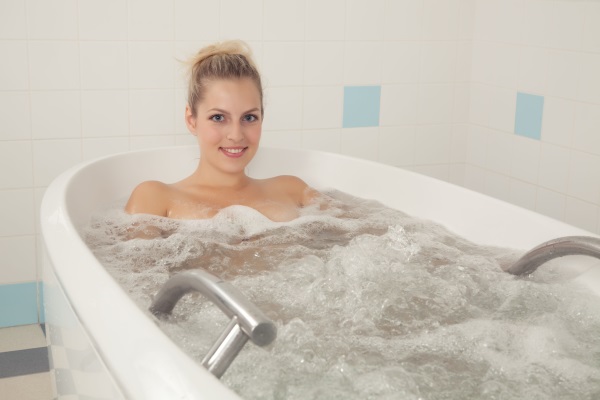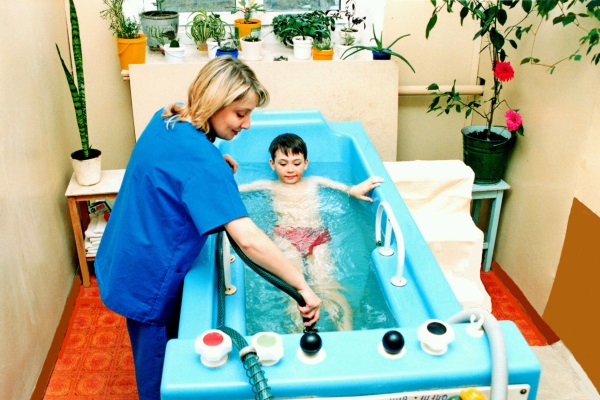Waving in physiotherapy occupies one of the first places in popularity and efficiency. Hydrotherapy is used in the treatment of diseases of various genesis since ancient times. Information on therapeutic properties of water takes the origins from remote times the history of mankind. The first data on water treatment is indicated in the Hindu works of Ayurveda 150 years BC. e. In their work, the drain technique described Pythagorars and Hippocrat. In ancient Rome, the first methods of treatment in terms and balnis developed asklepads. A large number of works on the hygienic, therapeutic properties of water, methods of wiping and compresses are written by the world-famous doctor Avicenna.
In the 19th century, S. Kneipp was very popular, which suggested systematic water treatments to harde the body in order to prevent diseases. To date, its name and system of hydrotherapy are known worldwide and apply to European clinics. Jean-Marin Charco, the creator of the shower of Sharko, which is currently used in the therapy of the pathologies of the musculoskeletal system, neurological diseases and metabolic processes (obesity). Soviet authors in their practice used mineral waters in therapy and rehabilitation of patients. Well known for its techniques of hardening by water Porfiry Ivanov.
The basis of hydrochief is a huge number of schemes. The effectiveness of this type of physiotherapy is proved by numerous scientific experiences and clinical trials. It is widely used with therapeutic, preventive and rehabilitation goal. At the sources of therapeutic waters, healthy hydropaths were built, their year-round visits a large number of patients with various diseases.
Varieties of water treatment
Hydroide is the use of water with various purposes, through individually developed schemes. This method consists of hydrotherapy and balneotherapy. The validity of the use of various types of hydraulic seasons was confirmed by clinical observations. For this method, various temperature modes are used: cold (cryotherapy) with a temperature of + 2-0 ° C, warm (thermotherapy) - + 40-90 ° C, medium-temperature - 0- + 40 ° C.
The mechanism of action of warm and cold temperatures consists in a peripheral arterial spa, reduction of heat transfer and heat conservation. Spasmned vessels prevent the penetration of hot blood to the internal organs and their overheating. Then the vessels are expanding, the heartbeat, breathing, is accelerated, the pressure is reduced, metabolism is accelerated. The heat transfer slows down, the body temperature rises, leading to the decay of proteins in an inflammatory focus, thereby increasing the protective functions.
In addition to the heat efficiency, the chemical qualities of mineral water are actively used.
Mineral baths include: sulfide, sodium chloride, uodobromic, carbon dioxide, oxygen, nitrogen. The positive effect is observed from the use of mineral sources for drinking therapy pathologies of internal organs. With the help of fresh and mineral waters, various baths, souls, intestinal irrigation are performed.

The following varieties of baths are distinguished: freshwater, mineral, with aromatic components and medicinal substances. Locally, the baths are served when the pelvis, belly and the upper part of the hip are immersed in water, and semi-handed - with a body immersion in the bath, filled to half with water. Common baths are:
- Steam - procedures are performed using water vapor.
- Fencing - with phenomena of foaming liquid or powder. The patient contacts only foam.
- Baths with step-by-step increase in temperature.
- Contrast baths.
- Vibrating baths are a combined effect of the healing effects of water and vibration of water waves on the necessary part of the body.
- Hydroelectric baths are built on a complex combination of a warm bath and a safe electric current.
- Hydropotage - stimulation of acupuncture points with a jet of water.
- Baths with mixing chemical component.
- Baths with the addition of turptine solutions.
- Mineral baths: sulphide, sodium chloride, yodobromic, radon.
- Pearl.
The bathing procedure is carried out in natural water bodies and artificial basins, and this type of physiotherapy includes steam and surrounding baths. A good healing result gives the use of the soul. Allocate the following types of shower:
- Circular - on the patient affects with water jets, with the necessary pressure and temperature.
- Scottish shower is an analogue of Charcot, it is distinguished by using an alternately hose with high and low temperatures water.
- Steam shower is carried out with a jet of steam.
- The upstream souls are carried out using a special tobupere, from which the water flows overlook, acting on the crotch.
- The shower Charcot perform the jet of water from the hose in 3-4 atm. At the distance of the patient 3-4 meters.

The mechanism of action of various types of water therapy
Of particular importance in the treatment of diseases has such a type of physipesis as baths. Their properties are characterized depending on the type of water used, temperature, composition and additional components. When using warm or cold baths, the influence occurs on the centers of neuro-endocrine regulation. Under their impact, blood circulation, metabolism and biochemical processes are accelerated. Baths with low temperatures increase the tone of vessels, slow down the pulse, lift blood pressure to low numbers. The warm bath is relaxing, accelerates heartbeat, a hypotensive effect occurs.
Warm baths have a significant antispaste effect on skeletal muscles and muscle organs, and cold - toning. The use of cool water activates the work of the nervous system, and the use of warm - lowers it. A significant effect on the temperature factor is obtained using contrasting procedures - alternating low and high-temperature baths. Warm aquatic activities enhance the work of the kidneys and increase the diuresis. Cold lead to the vessels of the urinary system vessels, reducing urine products.
The aqueous media act on rheological blood quality: warm water increases the coagulation rate, cold - increases blood viscosity and lowers coagulation.
Therapeutic effect of fresh water is carried out due to thermal and mechanical factor. With general procedures, the mechanical factor is carried out by hydrostatic pressure. Mineral waters additionally affect the skin of gas bubbles.
The mechanism of action of each procedure is varied. The healing effect of the soul is based on the mechanical and thermal irritation of the receptors of the skin and subcutaneous tissue. Under the influence of water jet throughout the body, blood circulation is activated, the delivery of oxygen and nutrients increases, metabolism is accelerated. Also increases the level of biologically active components and the durability of the body to external stimuli.
Each type of bath has its own special properties and their focus, it depends on its components. So, for example, the action of steam enhances the metabolism and has a coating effect. For hydroelectric baths, a sedative effect, an antispastic and painful property is characteristic. The main function of the vortex bath is to increase the tone of the veins, enhancing the filling of the skin microzosudes, reducing the tone of the sympathy-adrenal system, lowering the level of serotonin and histamine. White baths from the Allowers have a sharp irritating effect, extend the vessels, improving the microcirculation and nutrition of the tissue. Yellow turpentine acts on the nervous system, fatty exchange, blood pressure, stimulates metabolic processes.
Mineral waters possess some features:
- Sulfide baths are capable of normalizing metabolism, reduce platelet aggregation, increase the number of biologically active substances.
- Chloride sodium water enhance the reactivity of nerve cells and endocrine organs, increase the venous tone, have anti-inflammatory, antiallergic and painful effects.
- Yodobromic water normalizes the work of iron bodies and cells of the nervous system, restores the muscle tone, improves blood circulation in the liver and kidneys, reduces cholesterol, affects the function of the joints.
- Carbon dioxide enhances blood circulation, lowers the temperature, reducing the need for oxygen, as a result of which the pulse slows down and the cardiac emission is enhanced.
- Nitrogen water has a sedative effect on the nervous system and the heart.
Methods of water procedures

The session of the circular soul is carried out by action on the body of the patient of water pods in 1-2 atm. The water temperature is 30-36 ° C. The procedure lasts about 5 minutes, 10 sessions.
The upward souls are carried out by the direction of the jet in 1-2 atm. on the crotch area. The temperature difference fluctuates 20-25 ° C. The impact lasts for 10 minutes, the number of 15 sessions.
Shower Charcot spend water stream at a distance of 4 meters from the patient. Pressure jet 4 atm., Temperature 25-36 ° C. The procedure continues for 5 minutes. Course up to 12 sessions.
Aromatized baths make, interfering in 200 l water liquid or dry needle extract. The water temperature is 35-36 ° C, the session lasts 15 minutes. The course of therapy includes 10 baths.
For contrasting baths, two types of capacities with cold and warm liquid are prepared. The temperature difference at first is 5 ° C, upon completion of the course 20 ° C. The actions algorithm lies in a consistent dipping in the first and second bath. Staying in cold water lasts up to 2 minutes, in warm - 3 minutes. The procedure includes 5 shifts, total conduct 10 sessions.
The main scheme of the preparation of turpentine yellow and white baths is to prepare an emulsion that can be purchased at the pharmacy. The emulsion of the turpidar in an amount of from 15 to 60 ml is dissolved in water 50-60 ° C, with a volume of 3-5 liters. It is then poured into a container with warm water and mixed. The patient is immersed for 5-8 minutes or before the formation of Spains on the face. 10 sessions are held on the course.
Pearl baths are performed by special devices that form oxygen bubbles. Water is used comfortable temperature, if desired, coniferous extract can be used. Session duration of 15 minutes. Course 12 sessions.

Indications and contraindications to the use of water therapy
Water treatment is applied by various experts in therapy and the prevention of various pathologies:
- Diseases of the heart and vessels:
- Cardiosclerosis.
- Vices of the heart.
- Condition after commissioning.
- Congenital heart defects.
- Coronary artery disease.
- Stable angina stress 1-2 functional class.
- Myocardial infarction in history (no earlier than a year).
- Aorticoronary artery shunting (no earlier than a year since the operation).
- Cardiomyopathy.
- Hypertensive disease 1-2 stages.
- Arterial hypotension.
- Atherosclerosis of vessels of the lower extremities of 2 degrees.
- Trombalgitis during the period of remission with circulatory disorders 1-2 degrees.
- Thrombophlebitis (no earlier than 2 months from the moment of exacerbation).
- Varicose lack of lower extremities complicated by trophic ulcers.
- Angiospasm of peripheral arteries.
- Supporting vascular diseases.
- Reyno syndrome.
- Rheumatism outside the active stage.
- Diseases of the digestive tract:
- Chronic hepatitis in the stage of remission.
- Acute viral hepatitis (reconvalued).
- Reflux Ezophagitis.
- Chronic gastritis.
- Panish disease in the remission.
- Dumping-syndrome of moderate severity.
- Intestine dyskinesia.
- Chronic colitis, stage of remission.
- Chronic constipation.
- Dolichosigma.
- Respiratory diseases:
- Bronchial asthma, remission period.
- Chronical bronchitis.
- Chronic pneumonia.
- Diseases of the endocrine system:
- Tireotoxicosis 1-2 degrees.
- Hypothyroidism, compensation stage.
- Gout.
- Sugar diabetes, without ketoacidosis.
- Obesity.
- Blood Diseases:
- B12 deficient anemia, the stage of remission.
- Iron-deficiency anemia.
- Hypoplastic anemia.
- Hemolytic anemia, outside hemolysis.
- Chronic radiation disease.
- Chronic leukemia.
- Hemorrhagic diathesis of easy degree.
- Chronic heavily metals poisoning.
- Nervous System Diseases:
- Neurasthenia.
- Neuritis.
- Radiculitis.
- Sleep disturbance.
- Cerebral atherosclerosis.
- Vegetative polyneuropathy.
- Neurosis.
- Traumatic damage to the nervous system.
- Plexitis.
- Diseases of the musculoskeletal system:
- Injuries.
- Osteochondrosis.
- Arthritis.
- Arthrosis.
- Skin diseases:
- Vyachographant wounds.
- Varicose ulcers.
- Psoriasis.
- Neurodermatitis.
- Eczema.
- Scaly deprived.
- Female sexual diseases:
- Pathological climax.
- Inflammatory diseases in the remission stage.
- Pipe infertility.
- Chronic SalpingOforit.
- Endocrine forms of female infertility.
- Diseases of genital organs in men:
- Prostatitis.
- Orchit.
Conducting various types of hydrocations are limited in the following states:
- Diseases of various organs and systems under exacerbation or decompensation.
- Infectious diseases.
- Intoxication.
- Heat.
- Glaucoma.
- Weeping eczema.
- PEMFIGUS (bubble).
- Pregnancy.
- Pulmonary tuberculosis.
- Oncological diseases or suspicion of them.
- TECHNOLOGY TENDENCE TO GROWTH.
- Allergic reaction or individual intolerance to any components of physiotherapy.
- Arrhythmia.
- Acute purulent and unmarked processes.
- Acute thrombophlebitis.
- Epilepsy.

Before carrying out any physiotherapy procedure, including hydrotherapy, it is necessary to consult a doctor. It is especially important to carefully select the procedures to the child, based on its individual characteristics and age limitations for some techniques. The main rule of any session is to accurately fulfill the recommendations of the doctor. Like any type of treatment, water therapy has side effects: an allergic reaction by the type of urticaria, an increase or decrease in blood pressure, tachycardia, loss of consciousness.

